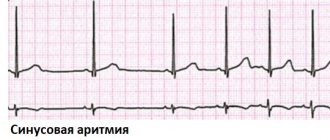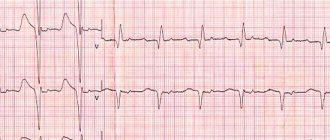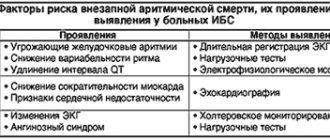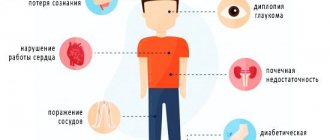Causes
The causes of hypercapnia are varied; they are divided into several large groups:
- Disturbances in the mechanics of respiratory movements in certain pathological conditions [with botulism, multiple sclerosis, poliomyelitis, muscular dystrophy, myasthenia gravis, the use of muscle relaxants, Pickwick's syndrome, morbid obesity, fractures of the sternum and (or) ribs, scoliosis, severe pneumosclerosis].
- Inhibition of the respiratory center in the brain stem (with the use of narcotic analgesics and general anesthetics, circulatory arrest, damage to the central nervous system, prolonged oxygen inhalation).
- Gas exchange disorders in the lung tissue (with Hamman-Rich disease, pneumothorax, Mendelssohn syndrome, respiratory distress syndrome, pulmonary edema, chronic obstructive pulmonary diseases, acute pneumonia).
Hypercapnia can develop when forced to spend a long time in a closed room without ventilation.
Hypercapnia is most dangerous for newborns and children in the first months of life. It can cause the development of severe neurological disorders.
Why is hypercapnia dangerous?
Hypercapnia is an increased level of carbon dioxide in arterial blood and body tissues. Not many people are familiar with this term, but almost everyone has felt the state characterized by this word.
Remember what you experienced in large crowds of people - in queues, in stuffy offices. Or a condition during respiratory diseases, when the nose is stuffy and the bronchi are clogged with mucus. The head begins to feel dizzy or hurt, there is severe weakness, nausea, the heart beats faster, and sweat appears.
In the article about the benefits of carbon dioxide, we already touched on the concept of hypercapnia. Let's take a closer look at what this term means?
Carbon dioxide in our body can be both beneficial and harmful. It all depends on the amount of its content. There is a concept of balance, the norm for this indicator is 4.7-6%.
The normal mechanism for removing carbon dioxide from the human body is through the lungs, by penetrating from the blood vessels into the alveoli. If for some reason this process is disrupted, hypercapnia
– increase in carbon dioxide content.
Then the CO2 pressure in the gas mixture rises to 55–80 mm Hg, and the oxygen level decreases. Simply put, carbon dioxide poisoning occurs.
exogenous in nature
and
endogenous.
Exogenous develops with an increased content of carbon dioxide in the air. It arises, one might say, for external reasons beyond your control: queues, stuffy rooms.
And endogenous hypercapnia is caused by internal reasons:
- Impaired breathing mechanism due to weakness of skeletal muscles, chest injuries (compression, fractures), morbid obesity, scoliosis.
- Depression of the respiratory center (less frequent breathing) associated with damage to the central nervous system, the use of pharmaceuticals (anaesthetics, narcotic analgesics), circulatory arrest, etc.
- Gas exchange disorders: pulmonary edema, COPD (chronic obstructive pulmonary disease), pleurisy (inflammation of the lining of the lungs), pneumothorax (accumulation of air in the pleural cavity), etc.
An increase in CO2 may also be a consequence of its increased formation in the body itself. The cause may be fever, sepsis, polytrauma, malignant hyperthermia.
The form of hypercapnia can be mild, and a person will not particularly feel it. Having left the stuffy room, he will quickly forget about the sensations he experienced - slight dizziness, redness of the skin, rapid heartbeat and breathing.
The initial form of hypercapnia, especially if it “forms” gradually (over several days, even a month), is easier for the human body to cope with. Adaptation and compensation mechanisms are included.
With deep hypercapnia, the symptoms are more aggressive. Here deviations may appear from several body systems at once.
- From the nervous system: agitation appears, symptoms of increased intracranial pressure (nausea, headache, bruises under the eyes, swelling, etc.).
- From the cardiovascular system: blood pressure continues to rise, pulse reaches 150 beats/min., there is a risk of bleeding.
- From the respiratory system. Symptoms of acute respiratory failure increase: the rhythm of breathing is disrupted, it becomes shallow and rare, bronchosecretion increases, the skin tone is bluish, and sweating is severe.
The most severe degree of hypercapnia (it is also the most dangerous) is hypercapnic coma. A person in a coma has no reflexes and consciousness, blood pressure drops sharply, and the skin tone is cyanotic (cyanotic). The result may be respiratory and cardiac arrest, i.e. death.
Hypercapnia poses a very great danger to women during pregnancy. We may be talking about a miscarriage due to the development of respiratory failure, increased blood pressure and impaired placental gas exchange.
The second scenario is that a child may be born with a pathology (mental and psychomotor development delay, cerebral palsy, epilepsy, etc.). High levels of CO2 negatively affect the baby’s nervous system, which is not yet fully developed.
How to stabilize the condition of a person suffering from hypercapnia?
The amount of assistance to the victim depends, of course, on the degree of carbon dioxide poisoning. To stabilize a person’s condition and reduce the risks of complications, it is necessary, firstly, to ensure a sufficient flow of oxygen. This is the simplest and at the same time the most important action.
If a person is unable to leave the stuffy room himself, he needs to be taken out into the air. Most often, this is enough to eliminate mild hypercapnia of an exogenous nature.
With endogenous (internal) origin, we are talking about eliminating the underlying disease or mitigating the severity of its symptoms. Some patients are prescribed systematic cleaning of the airways, liquefaction and removal of viscous bronchial secretions.
A good effect is obtained by keeping the patient in a cool room with a humidity level of more than 50%. To improve lung ventilation, bronchodilators are used - a group of drugs that can relax the muscular wall of the bronchi and thereby increase their clearance, as well as respiratory stimulants. Thanks to these measures, the patient's condition normalizes.
In case of severe carbon dioxide poisoning, you cannot do it on your own; you will need medical help, sometimes emergency. Otherwise the person may die.
In especially severe cases, doctors perform tracheal intubation (insertion of a special tube for intensive care), oxygen therapy (the patient breathes a balanced oxygen-nitrogen mixture), and resort to artificial ventilation.
In case of endogenous hypercapnia, which appears due to internal disturbances in the functioning of the body, it is contraindicated to do breathing exercises or conduct classes on breathing simulators.
But despite this, it was important for us to talk about this phenomenon and its consequences in the blog. After all, we often talk about the benefits of carbon dioxide, so it would be simply dishonest to remain silent about its harm.
If your doctor has diagnosed you with hypercapnia or acidosis, under no circumstances should you start using breathing machines. This may make the situation worse.
If you do not have such a diagnosis, and the carbon dioxide content is below normal, then you can purchase a breathing simulator. At the same time, there is no need to be afraid that you will develop serious endogenous hypercapnia.
Firstly, the simulator cannot lead to such a result; it is aimed only at improving the health of the body. Secondly, you can always measure the level of carbon dioxide using a special camera that comes with the simulator.
Carefully monitor your health, listen to all the “signals” of your body and subscribe to our blog to recognize them in time.
You can learn more about the Samozdrav breathing simulator by clicking on the link.
Signs
Clinically, hypercapnia can manifest as a slow increase in symptoms over a long period of time, and sometimes develops at lightning speed.
Signs of hypercapnia:
- rapid breathing (tachypnea);
- feeling of lack of air;
- excitement, followed by depression of consciousness;
- marbling of the skin, which then turns into pronounced cyanosis;
- participation in the act of breathing of auxiliary muscles;
- increased blood pressure and tachycardia, which, as the condition worsens, are replaced by hypotension and bradycardia;
- increased sweating (hyperhidrosis);
- heart rhythm disturbances;
- headache, dizziness;
- decreased performance;
- convulsive seizures.
Symptoms of hypercapnia
Hypercapnia - symptoms
The body is able to detect and partially compensate for low oxygen pressure or too much CO 2 in the blood. Mild symptoms of hypercapnia indicate activation of compensatory mechanisms. These symptoms include:
- skin redness
- drowsiness or inability to concentrate
- mild headaches
- feeling confused or dizzy
- shortness of breath,
- feeling of exhaustion, fatigue, insufficient to perform exercises.
These symptoms are a warning sign. If they persist for a long time, consult a doctor.
Severe symptoms of hypercapnia (respiratory failure in general) indicate that the system cannot compensate for the amount of oxygen and carbon dioxide. As a result of persistent respiratory failure, respiratory acidosis develops and cerebral vessels dilate.
Serious symptoms of respiratory failure with hypercapnia include:
- feel awkward
- unexplained feelings of paranoia or depression
- muscle tremors
- arrhythmia
- hyperventilation,
- seizures
- panic attack,
- get swoon.
Such symptoms are an indication for intervention and initiation of treatment.
An important consequence of chronic respiratory failure with hypercapnia is the so-called hypoxic respiratory drive. In a healthy person, the body reacts to an increased amount of CO 2 in the blood by breathing quickly. For example, in patients with chronic COPD, this reflex stops working. This carries the risk of respiratory arrest and hypercapnic coma if oxygen therapy is too intense.
About
Features of hypercapnia in children
In children, hypercapnia develops much faster and is more severe than in adults. This is explained by the anatomical and physiological characteristics of the child’s body, such as:
- narrowness of the respiratory passages - accumulations of mucus and swelling of the mucous membrane against the background of even minor inflammation can lead to a violation of their free patency;
- underdevelopment and weakness of the respiratory muscles;
- the ribs extend from the sternum almost at a right angle, which limits the excursion (mobility) of the chest in the act of breathing.
Features of hypercapnia in pregnant women
In pregnant women, especially in the third trimester, any breathing disorders can cause rapidly developing hypercapnia, which is associated with the following features:
- oxygen consumption during pregnancy increases by 20-23%;
- the type of breathing changes to the chest, the abdominal muscles cease to play the role of auxiliary respiratory muscles;
- there is a high standing of the diaphragm caused by the growing uterus, which prevents deepening of inspiration when the need arises.
In late pregnancy, hypercapnia can develop rapidly
Diagnostics
The primary diagnosis of hypercapnia is based on an analysis of the clinical picture. To confirm the diagnosis, as well as clarify the severity of respiratory failure, a study of the acid-base state of the blood is performed. Diagnostic signs of hypercapnia:
- increase in partial pressure of carbon dioxide - over 45 mm Hg. Art. (norm – 35–45 mm Hg);
- decrease in blood pH - less than 7.35 (normal - 7.35–7.45);
- an increase in bicarbonate content in the blood, which is compensatory in nature.
Hypercapnia can develop when forced to spend a long time in a closed room without ventilation.
The carbon dioxide content in exhaled air is also analyzed using a capnograph.
To diagnose hypercapnia, an acid-base state study is performed.
Treatment
Therapy for hypercapnia is aimed at eliminating the cause that caused it.
If symptoms of hypercapnia appear after staying in a stuffy room, it is enough to go outside or ventilate the room: this quickly leads to an improvement in the patient’s condition.
Treatment of hypercapnia against the background of inflammatory diseases of the respiratory system requires the prescription of antibacterial agents, bronchodilators, and anti-inflammatory drugs.
In case of hypercapnia caused by an overdose of narcotic analgesics, the administration of a specific antidote, Nalorphine, is indicated.
Sometimes, to get rid of the symptoms of hypercapnia, it is enough to ventilate the room
In acute hypercapnia, the patient is given humidified oxygen to breathe through nasal catheters or a face mask. In the case of a severe general condition of the patient, the issue of intubation and transfer to artificial ventilation is resolved.
Hypercapnia - treatment
Treatment of the underlying cause is very important in both respiratory failure and hypercapnia. In order to improve the patient's condition and normalize gasometric parameters, oxygen therapy of 60% is often used. oxygen mixture using the so-called Mustache or Venturi mask.
Severe respiratory failure is an indication for intubation and mechanical ventilation. Oxygen therapy should be used with caution in patients with COPD. The excess oxygen in these people can slow or even stop their own breathing, further worsening respiratory failure.
If compromised ventilation is caused by foreign body aspiration, bronchoscopy may be required. Appropriate antibiotic therapy will be the treatment for pneumonia.
Exacerbations of COPD and asthma are very common causes of respiratory failure. In the treatment of such exacerbations, bronchodilators and drugs that reduce swelling of the bronchial mucosa (mainly beta mimetics and glucocorticosteroids) are used. To avoid exacerbations, the most important thing is to stop smoking, take medications regularly and follow your doctor's instructions. Annual flu shots reduce the risk of infection, which can lead to flare-ups of the disease.
Vorobyova Marina
Neurologist of the highest qualification category (work experience 14 years), doctor of neurofunctional diagnostics (work experience 12 years); author of scientific publications on vertebroneurology; participant of scientific conferences on neurology and functional diagnostics of all-Russian and international significance.











